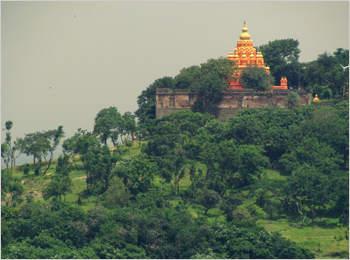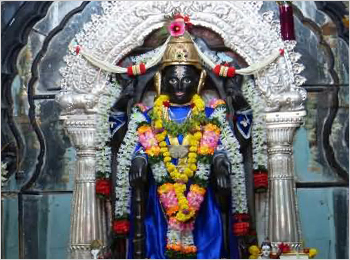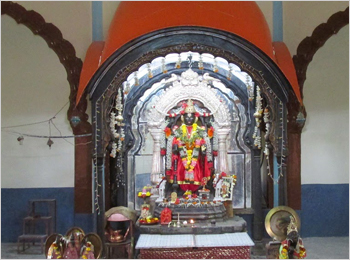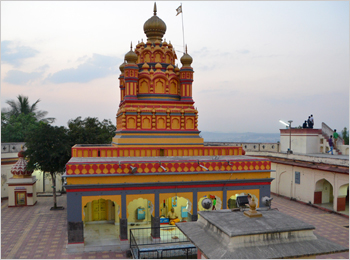- Shakti
Parvati Hill Temple
- Maharashtra
- View on map
- Tell us about this temple
Overview
The Parvati temple include temples of Devdeveshwar, God Kartikeya (Murugan), Vishnu and Vitthal located at 2100 feet above sea level and 260 feet from the city level. The temples on Parvati hill are the oldest and the most ancient heritage structures in Pune and are indicators of the Peshwa dynasty. Every temple has a place in the history of the Maratha Empire. It is believed that this temple is the oldest shrine which was specifically used for the prayers of Peshwa rulers in ancient era. Parvati hill is one of the most breathtakinging spots and the second highest scenic location in Pune comprising 103 steps.The hill offers panoramic view of the city to the visitors. One can also view picturesque scenery in the evening every day. A special black quarry stone was used for all the steps. It is weather-resistant and except for a few places, the stone has survived for over two hundred and fifty years even after being exposed to sun, wind and water. The steps are very wide to an extent that even an elephant can easily walk with all its panache towards the temple. They are not steep and even old people can climb easily.
About The Temple

Parvati Hill is situated in the south-east part of the city. The entire place was full of fields, trees and small dwellings during the Peshwa rule. The vast plains at the foothill were often used by feudal lords and dignitaries to put their camps when they visited the city with their armies. There are numerous references of Angres-the Controllers of Coastal area of the Maratha Empire, the Scindias and other Sardars camping luxuriously at the base of Parvati hill. When Sir Charles Mallet, the British envoy in the court of the last of the Peshwas came to present his credentials to the Maratha power, he camped at the the base of Parvati Hill for more than a week. After the breakdown of the Panshet water dam and subsequent devastation of parts of the city near the banks of the rivers, the entire base area of Parvati, which originally belonged to the Devdeveshwar Temple trust, was taken away by the government of Maharashtra and was used for building houses. It resulted in complete destruction of lush green fields and gave rise to the growth of slums.
Vetal Chabutra

A square plinth of stones in a plot situated at the foot of the hill is known as the Chabutra of Vetal. Some cloth pieces with sindoor can be seen here. Vetal is a deity worshipped by those who desire to acquire evil powers. Uneducated and unaware people used to indulge in such wicked tricks. Today the remains of this relic have almost disappeared into the ruins of stones and are hardly distinguishable; only the temple stands.
Mangir Buwa
A little further is a small place surrounded by hutments, known as Mangir Buwa. Mangir Buwa was a saintly person and had an influence over a particular community who worshipped him and used to settle their feuds and disputes in front of him.
The Math

Near the steps are visible some crumbled remains of a plinth. It is a dwelling meant for religious purpose and hence called a Math. A person of saintly character lived here where today almost nothing except a few foundation stones remain. The Trust has cleared the place and has a proposal for utilising the place.
Sati monument
At the centre of the hill can be seen a small temple-like structure, open on all four sides, with a flat top and squarish stone block inside. Long ago, a Brahmin priest namely Shri Mahadeo Shastri Dixit, was a great devotee of the lord. He knew nothing except the worship of the God and lived a very simple and austere life with his wife on Parvati hill. His wife, Ramadevi, herself a simple and faithful wife, followed her husband in his worship. When Mahadeo Shastri Dixit died, Ramadevi decided to immolate herself on the pyre along with her husband. This practice which is known as 'sati' was glorified in the past by the local population. This monument stands in memory of the couple who together left for the heavenly abode. This place is well built to give a panaromic view of the city. It is a pleasent experience to climb upto the Sati monument. There was a Talim Kholi (room for exercise) where the young rulers along with friends took regular exercise in the early hours of morning. It is interesting to note that meticulous care used to be taken regarding the education physical development of the youngsters in the royal households. During the Peshwa regime, this room was used to house the Peshwa artillery. Till 1879, guns were allowed to remain there. However after 1879, when the revolutionary, Vasudeo Balwant Phadke organised his opposition to the British Power and started the guerilla war, the British government ordered these guns to be removed permanently. To the righ,t there used to be Ghadyal Khana and Nagar Khana where there used to be a clock and a gong. Lately, a balcony is built from where one can view the entrance of the Parvati Hill.
Parvati Hill Attractions
Devdeveshwar Temple
This fine temple is dedicated to Lord Shiva in the form of a magnificent Shiv Linga. This temple is one of the best amongst the Parvati temple complex with a huge door made up of granite, entrance decorated by arches, and a mandapa holding the grand Shiv Linga. The Linga here is unique and believed to be brought from River Gandaki which flows in Nepal. Further, the linga is fixed within a brass seat which can’t be easily removed. It is also believed that the footwear of Chattrapati Shahu Maharaj lies beneath this Shiv Linga. The wall behind this Shiv Linga holds a outstanding idol of Lord Shiva with his spouse Parvati on one lap and son Ganapati on the other. It is said that the idol of Shiva was made out of pure silver and that of Parvati and Ganapati were made out of pure gold. However, these idols were stolen in 1932 after which similar were made but in brass.
Vishnu Temple
This temple was constructed along with the Devdeveshwar temple and holds a magnificent idol of Lord Vishnu which is around 4.5 feet high. This statue is too delivered from Gandaki and is pitch black in color. It has turned immensely smooth due to applying oil over it for several years. This outstanding idol is sculptured with four hands holding a lotus, a counch, the chakra, and a gadha respectively. The idol is further mounted upon a Laxmi Yantra which is a holy geometric form with several magical powers.
Kartikeya Temple
Lord Kartikeya is the eldest son of Lord Shiva and is considered as a bachelor god in Maharashtra. Thus, women are strictly prohibited to worship this god. The temple of Kartikeya here was built by Shrimant Raghobadada Peshwa. There are a large number of devotees of Lord Kartikeya who gather here during the auspicious day of Tripuri Poornima. Also, on this day, women too are permitted to take blessing from Kartikeya.
Shri Vitthal Rukmini Temple
The Vitthal Rukhmini temple is the latest amongst all the temples on the Parvati Hillock. Constructed using the Maratha style of architecture, this temple possess wonderful idols of Vitthal and Rukhmini.
Peshwa Museum
This museum holds several items possessed by the Peshwas. It is from this museum that we come to know that the Parvati Hill and Temple of Pune bore an idol which was carved out of gold by a craftsman from Karnataka, but it was stolen and replaced by a golden plated silver idol. This is a worth visiting museum and displays mighty swords, guns, wooden artifacts, coins, clothes, daily utilities, paintings, etc. Besides the Peshwa Museum,The samadhi of Balaji Baji Rao lies, where he spent the last moment of his life. Parvati water tank supplies water to the half of the city Pune.
Legend and Stories
The main temple, as it stands today, was built by the third Peshwa, Shrimant Nana Saheb in the year 1749 A.D. The history of the temple is linked with a miracle. It is believed that Kashibai, the mother of the third Peshwa was suffering from a severe ailment in her right foot. One of her advisors informed her about a temple of Goddess to the South of Pune which was famous for its miraculous healing power. Kashibai went to the temple which was located on top of this hill and prayed for her recovery. She vowed that if she was cured of her ailment, she would build a temple there. She soon recovered and her son built a temple on the hill. This was the famous Parvati temple.
Another belief is associated with the temple of Parvati. Chhatrapati Shri Shahu Maharaj, the ruling king of the Maratha Empire and the grandson of Chhatrapati Shivaji Maharaj, was pious, kind and a man of high moral character. He had special affection for his minister, young Nana Saheb Peshwa and he entrusted the entire business of the empire to him. The young Peshwa was the confidant of the king and was bestowed with his faith and affection.
The correspondence stands evidence to the fact that for the aged king, the young Peshwa was almost like a son. The death of King Shahu Maharaj was a personal loss to Nana Saheb. As a sign of remembrance, he brought the 'KHADAWA,' the wooden footwear of the late king and also an icon of Shivalinga with him from Satara to Pune and placed them underneath the Shivalinga of the main temple of Parvati. Though there is no evidence in writing about this episode but three events point out to the truth of this belief. Firstly, Nana Saheb Peshwa called the Shiva of Parvati hill temple by the name "Devadeveshwara" i.e."Lord of Lords" - suggesting its supreme position in the divinity. Secondly, Nana Saheb Peshwa paid personal attention to the Parvati temple. Thirdly, when he became seriously ill, he preferred to remain near his favourite deity, than to stay at his usual place. Noted historians have also pointed this fact that Nanasaheb Peshwa had special respect and love for Devadeveshwar at Parvati Hill.
It is true that the magnificant temples which stand today on the hill were built by the Peshwas. However, the hill of Parvati was known much earlier even in the days of Chhatrapati Shri Shivaji Maharaj. In a letter of grant (Inam-patra), granted under the seal of King Shivaji Maharaj, to one Brahmin Mahadbhat, son of Mudgalbhat Purandare, there is a clear reference to Parvati village.We can, therefore, conclude that Parvati hill was known in the Maratha days with some small temples on it. The temples stand as a reminder of Nana Saheb Peshwa's love for Chhatrapati Shri Shahu Maharaj.
Visit Duration
1 to 2 Hours
Entry Charge
Free
Accessibility
Airport
The nearest airport to Parvati Temple is lohegaon air force base airport , pune which is 12 km away from Parvati Temple.
Railways
The nearest railway station to Parvati temple is pune junction train station which is 4 km away from Parvati Temple.
Road
Reaching Parvati Temple is simple. The nearest bus station to reach here is the Swargate Bus Station. From here you can take auto rickshaw to reach this shrine.
Temple Address
Parvati Hill,
Parvati Paytha, Pune,
Maharashtra – 411009
Significance
Devotees visit this temple to seek fulfillment of the following:-
- Marriage
- Get married to a person of a girl's choice
- Health and longevity of husband
Shlokas
Sarva Mangala Maangalye Sive Sarvaardha Saadhike, Saranye Tryambake Gauri Naarayani Namosthuthe
Meaning -We offer you our salutations, Oh auspicious Naraayani, who is the good of all good, who can achieve everything and can offer refuge, Oh three-eyed Gowri.
Saranaangatha Dheenaartha Parithraana Paraayane Sarvasyaarthi Hare Devi Naaraayani Namosthuthe
Meaning -We offer salutations to you, Oh Narayani, who has the infinite power of creating, preserving and destroying. You are the basis and epitome of the 3 gunas.
Sarvaroope Sarvese Sarvasakthi Samanvithe, Bhayebhyastrahi No Devi Durge Devi Namosthuthe
Meaning -I offer my salutations to you mother Durga, who is present in all beings and has all power, save us from all our wrongdoings O mother of the universe.
Yaa Devi Sarva Bhooteshu Shakthi Roopena Samsthita Namastasyai Namastasyai Namastasyai Namo Namaha
Meaning -Salutations to the Goddess who resides as Shakti in all beings.
Timings
This temple is open from 05:00 am to 08:00 pm.
